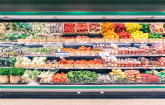ROCKVILLE, Md., Dec. 10, 2018 /PRNewswire/ -- Meal kits as a product have massive potential and will see increasing demand, according to market research firm Packaged Facts in the report Meal Kits: Trend and Opportunities in the U.S., 3rd Edition. However, the current e-commerce subscription-centric business model is not working for many traditional players in the industry. These companies are trying to offer meal kits for a reasonable price while delivering a variety of fresh ingredients from limited distribution points nationwide, which is a nearly impossible goal due to the high costs of shipping these specialized products.
Other food providers, such as grocery stores and convenience stores, have a lot of potential to develop meal kits and increase sales, which will further weigh on traditional meal kit companies as they experience increased competition. Some meal kit companies may be able to survive independently with the right strategies to keep existing customers, plus a combination of funding from investors and partnerships with favorable terms. Many others will have to be acquired by grocery stores, food companies, or e-commerce companies to survive.
A growing number of meal kit companies see acquisition by a grocery store as an opportunity not only for survival, but also for expansion. Customers are already used to going grocery shopping. Even the busiest people still purchase food from grocery stores for some of their needs, even if they are increasingly using online ordering and either curbside pickup or home delivery options for greater convenience. Meal kit companies can be integrated with store infrastructure for sales either in a store or for e-commerce fulfillment. Even when a grocery store is only offering online purchases with a third-party delivery service such as Instacart, meal kits can benefit since many customers want to be able to order all of their groceries through one platform.
While online grocery services are still pricey for grocers at the moment, they offer more value for customers than meal kit delivery services alone, and are thus competitive and potentially more sustainable in the long run. Even meal kit customers who enjoy not having to plan their meals still end up buying beverages, ingredients for other meals, snacks, and other products from stores.
"The potential synergies between meal kits and grocery stores are undeniable," says David Sprinkle, research director for Packaged Facts. "If meal kits are sold at grocery stores and are available for order online with a full suite of other groceries, customers are more likely to remain customers. Additionally, most meal kit companies would benefit by being able to take advantage of the grocer's supply chain for fresh ingredients."
Packaged Facts concludes that supply chain advantages stem from factors such as these:
- Grocers are able to work with food manufacturers that may be willing to produce meal kits (or portion-sized packages of ingredients for use in meal kits) and can package meal kits under a private label.
- Some grocers may also have dedicated food preparation employees who would be able to gather the ingredients for meal kits and package them in-store to promote maximum freshness.
An additional advantage to being acquired by a grocery store is that meal kits can be produced for less money and sold at a lower price by grocery stores, even if they are ordered by a customer online for pickup or delivery. Less packaging is needed for meal kits that are sold in a grocery store, as meal kits can be displayed and stored in refrigerated areas without needing to be shipped in boxes with cooling or insulating elements. Ingredient integrity often requires separate packaging of each ingredient in a plastic pouch when a meal kit is shipped, as scents and flavors can be easily absorbed by other ingredients during the long voyage. Additionally, many ingredients require different temperatures for peak freshness, necessitating that they be separated by packaging elements.
However, ingredients may not have to be separated this way if they are prepared in a store. For instance, paper bags might be a better option for customers, as they are more easily recycled. Paper bags can be used to separate fresh ingredients more readily when a meal kit is made to order, as the expected timeline for the product to reach the consumer and to be used is shorter. More ingredients can also be packaged together if they are used in the same step, as the concern of scent and flavor transfer is of less concern with a shorter timeline.
Where to Buy the Report
View additional information about Meal Kits: Trend and Opportunities in the U.S., 3rd Edition, including purchase options, the abstract, table of contents, and related reports at Packaged Facts' website: https://www.packagedfacts.com/Meal-Kits-Trend-Opportunities-Editon-11984597/.
About Packaged Facts
Packaged Facts, a division of MarketResearch.com, publishes market intelligence on a wide range of consumer market topics, including consumer demographics and shopper insights, consumer financial products and services, consumer goods and retailing, and pet products and services. Packaged Facts also offers a full range of custom research services. Reports can be purchased at our company website and are also available through MarketResearch.com.
For more essential insights from Packaged Facts be sure to follow us on Twitter and Google+. Please link any media references to our reports or data to https://www.packagedfacts.com/.
Press Contact:
Daniel Granderson
240.747.3000
[email protected]
SOURCE Packaged Facts
Related Links
WANT YOUR COMPANY'S NEWS FEATURED ON PRNEWSWIRE.COM?
Newsrooms &
Influencers
Digital Media
Outlets
Journalists
Opted In





Share this article